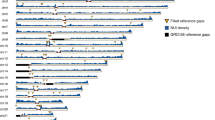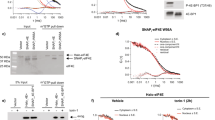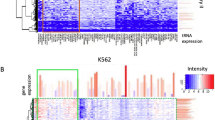Abstract
We report an in vitro selection strategy to identify RNA sequences that mediate cap-independent initiation of translation. This method entails mRNA display of trillions of genomic fragments, selection for initiation of translation and high-throughput deep sequencing. We identified >12,000 translation-enhancing elements (TEEs) in the human genome, generated a high-resolution map of human TEE-bearing regions (TBRs), and validated the function of a subset of sequences in vitro and in cultured cells.
This is a preview of subscription content, access via your institution
Access options
Subscribe to this journal
Receive 12 print issues and online access
$259.00 per year
only $21.58 per issue
Buy this article
- Purchase on SpringerLink
- Instant access to full article PDF
Prices may be subject to local taxes which are calculated during checkout



Similar content being viewed by others
References
Sonenberg, N. & Hinnebusch, A.G. Cell 136, 731–745 (2009).
Jackson, R.J., Hellen, C.U.T. & Pestova, T.V. Nat. Rev. Mol. Cell Biol. 10, 113–127 (2010).
Shatsky, I.N., Dmitriev, S.E., Terenin, I.M. & Andreev, D.E. Mol. Cells 30, 285–293 (2010).
Johannes, G., Carter, M.S., Eisen, M.B., Brown, P.O. & Sarnow, P. Proc. Natl. Acad. Sci. USA 96, 13118–13123 (1999).
Spriggs, K.A., Stoneley, M., Bushell, M. & Willis, A.E. Biol. Cell 100, 27–38 (2008).
Roberts, R.W. & Szostak, J.W. Proc. Natl. Acad. Sci. USA 94, 12297–12302 (1997).
Salehi-Ashtiani, K., Luptak, A., Litovchick, A. & Szostak, J.W. Science 313, 1788–1792 (2006).
Korbel, J.O. et al. Science 318, 420–426 (2007).
Kasowski, M. et al. Science 328, 232–235 (2010).
Gilbert, W.V., Zhou, K.H., Butler, T.K. & Doudna, J.A. Science 317, 1224–1227 (2007).
Baranick, B.T. et al. Proc. Natl. Acad. Sci. USA 105, 4733–4738 (2008).
Moss, B. Science 252, 1662–1667 (1991).
Van Eden, M.E., Byrd, M.P., Sherrill, K.W. & Lloyd, R.E. RNA 10, 720–730 (2004).
Mitchell, S.F. et al. Mol. Cell 39, 950–962 (2010).
Mokrejs, M. et al. Nucleic Acids Res. 38, D131–D136 (2010).
Sakharkar, M.K., Chow, V.T. & Kangueane, P. In Silico Biol. 4, 387–393 (2004).
Akey, J.M. Genome Res. 19, 711–722 (2009).
Sabeti, P.C. et al. Science 312, 1614–1620 (2006).
Traynelis, S.F. et al. Pharmacol. Rev. 62, 405–496 (2010).
Langmead, B., Trapnell, C., Pop, M. & Salzberg, S.L. Genome Biol. 10, R25 (2009).
Ji, H.K. et al. Nat. Biotechnol. 26, 1293–1300 (2008).
Kin, T. & Ono, Y. Methods Biochem. Anal. 23, 2945–2946 (2007).
Thomas, P.D. et al. Genome Res. 13, 2129–2141 (2003).
Auerbach, R.K. et al. Proc. Natl. Acad. Sci. USA 106, 1492–1493 (2009).
Acknowledgements
We thank J. Szostak (Harvard Medical School) and J. Doudna (University of California–Berkeley) for providing the human genome library and luciferase vectors, respectively; N. Pakulis, M. Leon, J. Flores and K. Fenton for technical assistance; G. McInnes for initial bioinformatics analysis; and members of the Chaput laboratory for helpful discussions and comments on the manuscript. This work was supported by US National Institutes of Health to J.C.C. (Eureka Award; GM085530) and S.K. (HG002096-11).
Author information
Authors and Affiliations
Contributions
J.C.C. conceived the project. J.C.C., B.P.W., B.L.J., S.K. and L.L. designed the experiments. B.P.W., B.S., K.W., A.C.L., K.K. and N.B. performed the experiments. J.C.C., B.P.W., A.C.L., K.K., L.L., S.K. and M.S. analyzed the data. J.C.C. wrote the manuscript with input from all authors.
Corresponding author
Ethics declarations
Competing interests
B.L.J., S.K. and J.C.C. are named inventors on a patent application (PCT/US11/44198) on the technology described in this manuscript.
Supplementary information
Combined PDF
Supplementary Figures 1–5 and Supplementary Tables 1–4 (PDF 2424 kb)
Rights and permissions
About this article
Cite this article
Wellensiek, B., Larsen, A., Stephens, B. et al. Genome-wide profiling of human cap-independent translation-enhancing elements. Nat Methods 10, 747–750 (2013). https://doi.org/10.1038/nmeth.2522
Received:
Accepted:
Published:
Issue date:
DOI: https://doi.org/10.1038/nmeth.2522
This article is cited by
-
Tailor made: the art of therapeutic mRNA design
Nature Reviews Drug Discovery (2024)
-
A researcher’s guide to the galaxy of IRESs
Cellular and Molecular Life Sciences (2017)
-
IRES-dependent translated genes in fungi: computational prediction, phylogenetic conservation and functional association
BMC Genomics (2015)



